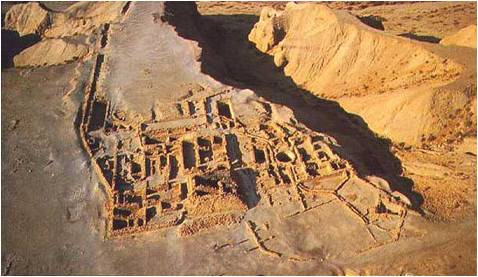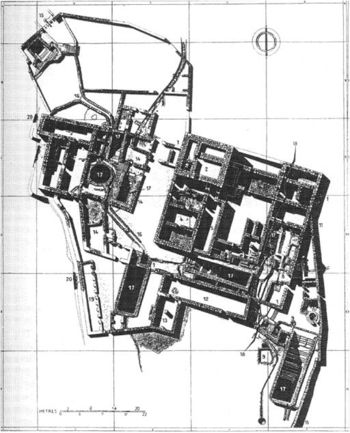Difference between revisions of "Category:Qumran (subject)"
(Created page with "700px thumb|350px '''Qumran / Khirbet Qumran''' is an archeological site located in the West Bank on a dry plateau about a m...") |
|||
| (One intermediate revision by the same user not shown) | |||
| Line 2: | Line 2: | ||
[[File:Qumran map.jpg|thumb|350px]] | [[File:Qumran map.jpg|thumb|350px]] | ||
'''Qumran''' (see [[Archaeology]] & [[Qumran Studies]]) | |||
* [[Biblical Archaeology]] -/- [[Jesus Archaeology]] | |||
==Overview== | |||
'''Qumran / Khirbet Qumran''' is an archeological site located in the West Bank on a dry plateau about a mile from the northwestern shore of the Dead Sea, in the area in which most of the [[Dead Sea Scrolls]] were found. | '''Qumran / Khirbet Qumran''' is an archeological site located in the West Bank on a dry plateau about a mile from the northwestern shore of the Dead Sea, in the area in which most of the [[Dead Sea Scrolls]] were found. | ||
Latest revision as of 17:50, 7 November 2019
Qumran (see Archaeology & Qumran Studies)
Overview
Qumran / Khirbet Qumran is an archeological site located in the West Bank on a dry plateau about a mile from the northwestern shore of the Dead Sea, in the area in which most of the Dead Sea Scrolls were found.
The settlement was constructed during the Hasmonean period (late 2nd century BCE) and was occupied until 68 BC, when it was destroyed by the Romans during the Jewish War, and never rebuilt. Most scholars see a close connection between the scrolls and the settlement; Qumran was the home of a sectarian community who collected the scrolls and authored some of them.
Archeology of Qumran
The site had been known to European explorers since the 19th century. The first to visit the site was Louis Félicien de Saulcy in 1851, followed by Henry Poole in 1855, Albert Augustus Isaacs in 1856, Charles Clermont-Ganneau in 1873, Ernest William Gurney Masterman 1900-01, and Gustaf Dalman in 1914. No systematic excavation was carried out. The ruins were commonly understood as those of a fort, even though the presence of the large cemetery was puzzling.
Interest in the site arose in the late 1940s when the first Dead Sea Scrolls were found in nearby caves. The site was extensively excavated in the 1950s by archaeologists under the direction of Roland de Vaux. De Vaux interpreted the ruins as the home of a community of Essenes who lived a quasi-monastic life devoted to prayer and the study and writing of religious documents.
Main Gate
Tower
Scriptorium
Roland de Vaux identified one of the excavated rooms as the Scriptorum of the community, as several inkwells were found there. Some of the stone furniture that collapsed from the second floor was tentatively reconstructed as "tables" and "benches" used by scribes to write the scrolls.
Assembly Hall (Refectorium)
A large rectangular room at the southern section of the settlement was identified by de Vaux as an assembly hall (or refectorium). Several elements advance such an identification. First of all the dimensions, the presence of a water channel (which would have facilitated the cleaning) and a miqveh (ritual bath) directly outside the room (which would have facilitated the rituals of purification.
Kitchen
Pantry
Water System
Qumran had a quite elaborate water system, a complex network of aqueducts and cisterns. In the dry and hot environment, water was necessary for drinking and bathing, but also to satisfy the purity concerns of the community.
Toilet
Cemetery
A large cemetery, located 30-40 meters east of the main living area, has been found at Qumran. The analysis of the cemetery is complicated by the fact that the cemetery was later used by Muslim Bedouins. However, the old cemetery clearly distinguishes itself for some unique features:
- All tombs are arranged in ordered rows, with a north-south orientation.
- There are no family tombs but only individual tombs.
- The absence of women and children under the age of 16 demonstrates that Qumran was home to a male-oriented religious community.
The Economic Life at Qumran
External links
Pages in category "Qumran (subject)"
The following 13 pages are in this category, out of 13 total.
1
- (+) The Excavations at Qumran = Vondsten in de woestijn van Juda (1958 @1957 Ploeg / Smyth), book (English ed.)
- Qumran (1961 Grözinger), book
- Qoumrân, l'établissement essénien des bords de la mer Morte (1976 Laperrousaz), book
- Qumran (1982 Davies), book
- Los esenios de Qumrán (1995 Vidal Manzanares), book
- Yom be-Kumran: ha-hayim be-kat Midbar Yehudah (1997 Roitman), book
2
- Sectarios de Qumrán: Vida cotidiana de los esenios (2000 Roitman), book (Spanish ed.)
- Qumran in Context: Reassessing the Archaeological Evidence (2004 Hirschfeld), book
- Qumran: The Site of the Dead Sea Scrolls: Archaeological Interpretations and Debates (2006 Galor, Humbert, Zangenberg), edited volume
- Qumran: Scrolls, Caves, History (2009 Eshel), book (English ed.)
- קומראן (Qumran / 2009 Eshel), book
- Qumran und die Archäologie (Qumran and Archaeology / 2011 Frey, Claussen, Kessler), edited volume
- Qumran: le rovine della luna (2011 Paganini), book
Media in category "Qumran (subject)"
The following 5 files are in this category, out of 5 total.
- 1961 * Vaux.jpg 317 × 499; 19 KB
- 1973-T * Vaux en.jpg 400 × 604; 12 KB
- 2002 * Magness.jpg 334 × 499; 30 KB
- 2013 Paganini.jpg 314 × 499; 16 KB
- 2021 * Magness.jpg 331 × 499; 31 KB






